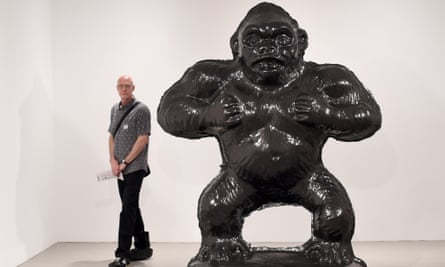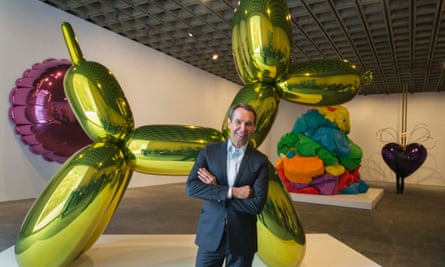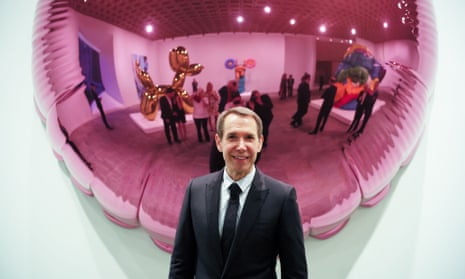Jeff Koons is an impossible artist. That’s a large part of his appeal, in fact: he creates fantastic, impossible objects. And if you succeed in looking behind the mirror-polished surface of his art, you’ll see something quite fascinating, something which speaks volumes about the status of contemporary art in today’s society.
That said, Koons really doesn’t want you looking behind the surface. He’s the king of superficies: you fall in love with his Puppy immediately, involuntarily, unironically. He will critique the banality of consumerism, but he does so by exalting it: never have brand-new vacuum cleaners looked so desirable or perfect. His longest lasting, most expensive, most seductive series of works is actually called Celebration. When you see one of those pieces in the flesh, especially in the beautifully curated context of the Whitney’s massive retrospective, it overwhelms you with its size and presence and reflective depthlessness. It’s bling, but it’s venerable bling, equally at home in the halls of Versailles or in the Whitney’s stark modernist spaces. This isn’t easy: Koons is a man who gives a whole new meaning to the term lightweight.
It also isn’t cheap. Artnet tallied up the market value of the works in the Whitney exhibition, and arrived at a number somewhere north of half a billion dollars, and that represents just a fraction of Koons’s total output. (Almost every sculpture, for instance, comes in an edition of three, or five.) Yet: pretty much the best way to go bust in the art world, over the past couple of decades, has been by signing on as Jeff Koons’s dealer.
The reason is that these works aren’t just expensive in the auction house, mark-to-market sense of the term; they’re also incredibly expensive to manufacture. Koons is a technologist as much as he is an artist: he is personally responsible for the development of multiple cutting-edge fabrication techniques, and you can be quite sure that for every finished success, standing in glorious perfection in the middle of a gallerist’s white cube or being reflected in the glass curtain wall of some plutocrat’s skyscraper, there were a dozen failures along the way. Look at Koons’s Gorilla: he’s managed to recreate the texture and feeling of a cheap wax toy, in solid granite, and at awesome scale. This is, truly, folly: for nearly all of his career, Koons’s perfectionism has caused him to lose money on many if not most of the pieces he sells.

In the beginning, it was Koons personally who lost money. Even when he was doing something as simple as buying a Nike advertising poster and framing it, his desire for flawlessness caused the costs involved to spiral. Later on, Koons’s dealers bore the brunt, especially the long-suffering Jeffrey Deitch. But then, once he had driven at least three dealers into bankruptcy, Koons (re)discovered – and perfected – a whole new art: the art of selling to collectors objects which don’t actually exist. Over and over again.
Koons’s economic breakthrough – and such a breakthrough was desperately needed, if works like his magnificent Play-Doh were ever to be realized – was the kind of financial innovation worthy of Blythe Masters and Peter Hancock, the JP Morgan bankers who invented credit derivatives. Or, more to the point, it was an innovation worthy of Michael Dell, who became a billionaire by flipping the model of making computers and then selling them, into a model of selling computers and then making them.
Other sculptors, like Rodin, did something similar in the past: they would exhibit plaster or terracotta versions of their sculptures, which would then be commissioned in stone or in bronze and manufactured only after they had been paid for. But back then the only difficulty with fabrication was cost. Koons, by contrast, has for decades been selling sculptures he has no idea (at the time) how to make.
Play-Doh is the ultimate example of this. It was bought 20 years ago, by Los Angeles soap-opera magnate Bill Bell. But Play-Doh was – is – the opposite of a simple assembly-line sculpture. Koons was trying to do something which had never been done before – and he failed, and failed again, and failed again, and each time he picked himself up and kept on working at it.

Which is where the real financial innovation comes in. Bell’s initial payment for Play-Doh might have covered the anticipated manufacturing costs, 20 years ago. But it didn’t come close to covering the cost of every single subsequent iteration, before the piece was finally perfected. So when costs started overrunning, Koons did something very clever indeed – he simply went back to his collectors, who had already bought and paid for the works in question, and asked them for more money.
At that point, the collectors had two choices. They could cough up – in the knowledge that Koons would almost certainly come back for even more, a few more steps down the road – or they could say no, and get their money back.
In any sensible art world, Koons’s financial innovation would never have worked. Let’s say that you’re willing to pay $20,000 for a work which costs $7,000 to fabricate. You pay the $20,000 up front, and are then told hey, we’ve had a massive cost overrun, please pay us another $20,000 or get your money back. You would just say thanks, I’ll have my money back. I was willing to pay $20,000, but I’m not willing to pay $40,000.
In the fevered upper echelons of the contemporary art market, however, values can soar overnight; artworks are bought at least in part for their speculative value; and the amount that someone is willing to pay for a piece is mostly a function of how much someone else is willing to pay for that same piece.
What Koons discovered was that so long as his work was rising in value, few collectors would give up a work they had bought at a lower price – even a work that didn’t exist. And if they did, no harm, no foul – there was always a long line of new collectors happy to step into their shoes. Koons, very cleverly, found a way of exploiting the mark-to-market mentality that is now ubiquitous in the art world: the way in which collectors are hyper-aware of how much their art is worth. So long as the collectors could credibly believe that they had “made money” on their non-existent art, they were generally happy to keep on funding it – in Bell’s case, for some 20 years.

The Koons model is a little bit like the patronage model, where a wealthy patron will pay an artist’s expenses in return for his artistic output. But Koons flipped that model: he had the collectors working for him, more than the other way around. They weren’t calling the shots: he was. (One Koons collector told me recently that he once made the artist an offer: he’d pay double the asking price, if Koons guaranteed that he’d never come back and ask for more. No dice.)
Koons’s model only works, of course, in a commoditized art world where prices are constantly rising. But it does work – and it has even produced masterpieces like Play-Doh. No dealer could have afforded to fund the production of multiple such pieces, and so Koons developed not only brand-new fabrication techniques, but also brand-new funding techniques to keep his hugely expensive R&D machine running.
Look closely at the shiny surfaces of the massive sculptures in the Celebration series – the Balloon Dog, say – and you won’t see a single seam; you won’t see any visible evidence of how the piece was made. Look at the bronze and aluminum copies of blow-up toys, and you’ll swear you could just pop them with a pair of scissors. Koons’s trompe l’oeil is the very best the art world has ever seen, because of his incredible level of perfectionism. No one has done anything like it before, because the technology didn’t exist, and because the sums of money involved in creating such things are so mind-boggling.
Koons, more than any other artist, has embraced the new possibilities that open up when you can charge seven- or even eight-figure sums for a single piece: his art is like the new luxury apartment buildings going up in Manhattan, which only make financial sense once the residences inside can sell for more than $5,000 per square foot. Koons’s art might be empty; it might be banal. But Koons does something very interesting, which very few other artists do. He turns money into art, rather than just turning art into money.

Comments (…)
Sign in or create your Guardian account to join the discussion